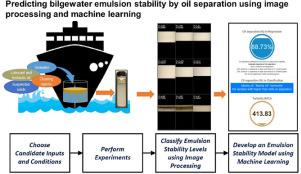Water Research ( IF 11.4 ) Pub Date : 2022-08-14 , DOI: 10.1016/j.watres.2022.118977 Woo Hyoung Lee 1 , Cheol Young Park 1 , Daniela Diaz 1 , Kelsey L Rodriguez 1 , Jongik Chung 2 , Jared Church 3 , Marjorie R Willner 3 , Jeffrey G Lundin 4 , Danielle M Paynter 3

|
Bilgewater is a shipboard multi-component oily wastewater, combining numerous wastewater sources. A better understanding of bilgewater emulsions is required for proper wastewater management to meet discharge regulations. In this study, we developed 360 emulsion samples based on commonly used Navy cleaner data and previous bilgewater composition studies. Oil value (OV) was obtained from image analysis of oil/creaming layer and validated by oil separation (OS) which was experimentally determined using a gravimetric method. OV (%) showed good agreement with OS (%), indicating that a simple image-based parameter can be used for emulsion stability prediction model development. An ANOVA analysis was conducted of the five variables (Cleaner, Salinity, Suspended Solids [SS], pH, and Temperature) that significantly impacted estimates of OV, finding that the Cleaner, Salinity, and SS variables were statistically significant (p < 0.05), while pH and Temperature were not. In general, most cleaners showed improved oil separation with salt additions. Novel machine learning (ML)-based predictive models of both classification and regression for bilgewater emulsion stability were then developed using OV. For classification, the random forest (RF) classifiers achieved the most accurate prediction with F1-score of 0.8224, while in regression-based models the decision tree (DT) regressor showed the highest prediction of emulsion stability with the average mean absolute error (MAE) of 0.1611. Turbidity also showed a good emulsion prediction with RF regressor (MAE of 0.0559) and RF classifier (F1-score of 0.9338). One predictor variable removal test showed that Salinity, SS, and Temperature are the most impactful variables in the developed models. This is the first study to use image processing and machine learning for the prediction of oil separation for the application of bilgewater assessment within the marine sector.
中文翻译:

使用图像处理和机器学习通过油分离预测舱底水乳液稳定性
舱底水是一种船载多组分含油废水,结合了众多废水源。正确的废水管理以满足排放法规需要更好地了解舱底水乳液。在这项研究中,我们根据常用的海军清洁剂数据和之前的舱底水成分研究开发了 360 个乳液样品。油值 (OV) 从油/奶油层的图像分析中获得,并通过油分离 (OS) 进行验证,油分离 (OS) 是使用重量法实验确定的。OV (%) 与 OS (%) 表现出良好的一致性,表明一个简单的基于图像的参数可用于乳液稳定性预测模型的开发。对五个变量(清洁剂、盐度、悬浮固体[ SS ]、pH和温度)显着影响 OV 的估计值,发现清洁剂、盐度和SS变量具有统计学意义(p < 0.05),而pH 值和温度不是。一般来说,大多数清洁剂通过添加盐来改善油分离。然后使用 OV 开发了基于机器学习 (ML) 的新型舱底水乳液稳定性分类和回归预测模型。对于分类,随机森林 (RF) 分类器以 0.8224 的 F1 分数实现了最准确的预测,而在基于回归的模型中,决策树 (DT) 回归器以平均平均绝对误差 (MAE) 显示出最高的乳液稳定性预测) 的 0.1611。使用 RF 回归器(MAE 为 0.0559)和 RF 分类器(F1 评分为 0.9338),浊度也显示出良好的乳液预测。一项预测变量去除测试表明,盐度、SS和温度是已开发模型中影响最大的变量。这是第一项使用图像处理和机器学习来预测油分离的研究,以便在海洋部门应用舱底水评估。











































 京公网安备 11010802027423号
京公网安备 11010802027423号